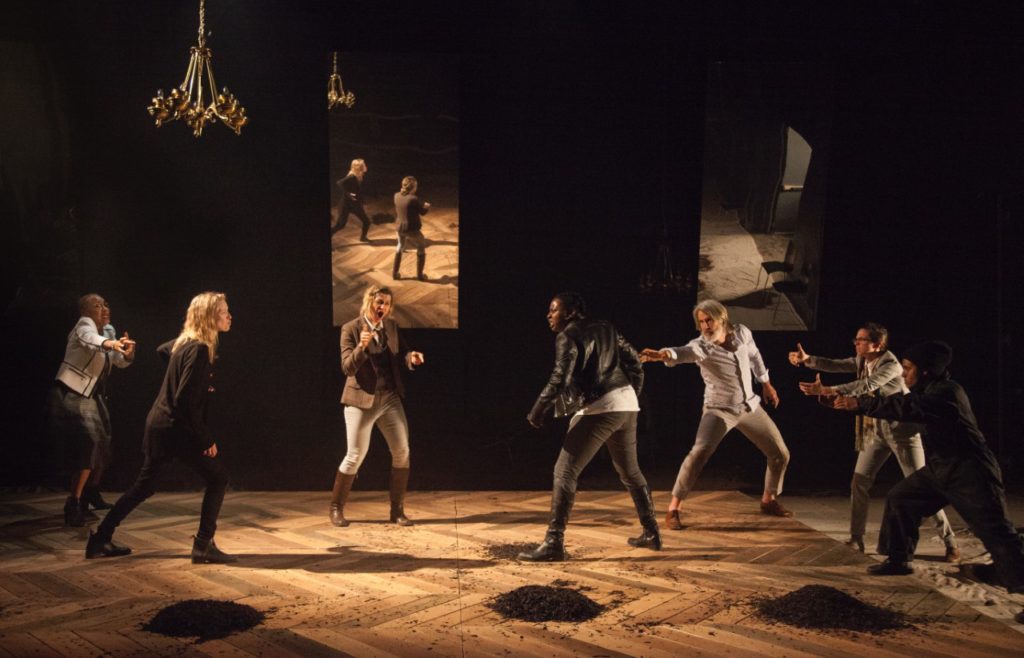NAC’s Prince Hamlet gives bold, modern, and captivating twist to classic play

Photo Bronwen Sharp. The National Arts Centre’s Prince Hamlet from Toronto’s Why Not Theatre is a daring production that turns the classic play on its head and proves that a postmodern spin on the classics can pay off big.
The play is directed by Toronto-based Ravi Jain, whose bold vision demonstrates that a 400-year-old play can always be mined for captivating new details.
Hamlet is one of the most iconic protagonists in theatre, and Christine Horne ably steps into the role in this gender-bent version. After ten minutes you might forget that Hamlet ever was a man, so perfectly does Horne embody the moody character. Hamlet’s gender-bending is by far the most seamless—the gender-switching of Laertes, Polonius, Rosencrantz and Guildenstern and Ophelia is not quite as effortless or effective.
Prince Hamlet is a cathartic experience, a play that explores agony, depression, insanity, and darkness better than just about any other. While some of that is owed to Shakespeare’s writing, Jain’s production enhances all those elements. His is a version that presents madness far more depraved than one can glean from reading the text. If Shakespeare’s words show us pain, Jain’s production shows us abject suffering. That’s no slight against the play though—the show is beautiful, both thematically and visually.
This adaptation puts pain and madness first but evokes them in a highly aesthetic way. This version also emphasizes the serious relationship between Hamlet and Ophelia, played by Jeff Ho. A lot of stage time is devoted to their romance and its fatal collapse. In the vein of love, the play also has an emphasis on sexual impropriety, as the sexual relationship between his mother Gertrude and uncle Claudius is foregrounded as an important motive for killing Claudius. In this version of the play, love, sex, and madness are major themes.
In addition to excellent acting, what really elevates the show from just-another-Shakespeare-take to experimental piece of new theatre is its lighting, sound, and set design. Designed by André du Toit, Thomas Ryder Paine, and Lorenzo Savoini respectively, the show’s lighting, sound, and set are essential elements to creating the show’s dark atmosphere.
The lighting leans toward starkly lit and is at its best when accentuating soliloquys. The set and props are minimal, held together by large mirrors on the back wall and mounds of dirt on the sides of the stage. The mirrors are especially well-used, offering am interesting angle for soliloquizing—Hamlet, for instance, attempts to talk to his father’s ghost in the mirror while lit harshly from behind. The mounds take on increasing importance as burial mounds; Ophelia, for example, covers herself in dirt before her drowning.
Paine’s sound design heightens every emotion in the production. Almost all parts of the show are underpinned with a somber drone or low-tempo electronic beats that accentuate the depression in Hamlet’s soliloquys, the intensity in Polonius’ anger, the depths of Ophelia’s despair, and every other aspect of the show. One incredible
example combines manic noise with strobe lights to symbolize Hamlet being pushed to the edge of madness as he imagines Claudius and his mother making love, as the two actors dry-hump on stage. Like lyrics made sadder by mournful music, the pain in Shakespeare’s words is pushed to the limit, revealing new depths to the centuries-old play.
The other major element to the play outside the lighting and sound is the use of sign language as an integrated plot point. Horatio—whom Jain says in his director’s notes is the central character in this adaptation—never speaks but communicates only through sign language. Instead of signing with the words spoken over it, many parts of the play are only in sign language, and Hamlet and Horatio use sign language to have conversations that are even secret to most of the audience. It creates a unique situation where the audience—unless they know sign language—misses parts of the play; in fact, misses most of the dialogue between Hamlet and Horatio. It also puts an emphasis on verbal silence, typically underpinned by a drone, that just acts as another way to capture the audience’s interest.
Prince Hamlet certainly has many experimental elements, especially at the ending (without giving away too much, the audience is denied a straightforward duel between Laertes and Hamlet; the fight is, instead, shown through Horatio) but the production shows perfectly that a classic play can always be approached in a modern way.